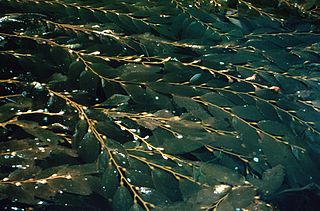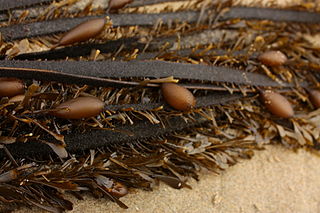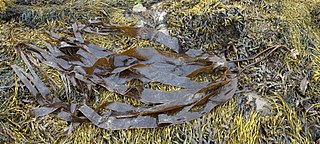
Kelps are large brown algae or seaweeds that make up the order Laminariales. There are about 30 different genera. Despite its appearance, kelp is not a plant but a stramenopile, a group containing many protists.

Brown algae, comprising the class Phaeophyceae, are a large group of multicellular algae, including many seaweeds located in colder waters within the Northern Hemisphere. Brown algae are the major seaweeds of the temperate and polar regions. They are dominant on rocky shores throughout cooler areas of the world. Most brown algae live in marine environments, where they play an important role both as food and as a potential habitat. For instance, Macrocystis, a kelp of the order Laminariales, may reach 60 m (200 ft) in length and forms prominent underwater kelp forests. Kelp forests like these contain a high level of biodiversity. Another example is Sargassum, which creates unique floating mats of seaweed in the tropical waters of the Sargasso Sea that serve as the habitats for many species. Many brown algae, such as members of the order Fucales, commonly grow along rocky seashores. Some members of the class, such as kelps, are used by humans as food.

Nereocystis is a monotypic genus of subtidal kelp containing the species Nereocystis luetkeana. Some English names include edible kelp, bull kelp, bullwhip kelp, ribbon kelp, bladder wrack, and variations of these names. Due to the English name, bull kelp can be confused with southern bull kelps, which are found in the Southern Hemisphere. Nereocystis luetkeana forms thick beds on subtidal rocks, and is an important part of kelp forests.

Fucus is a genus of brown algae found in the intertidal zones of rocky seashores almost throughout the world.

Palmaria palmata, also called dulse, dillisk or dilsk, red dulse, sea lettuce flakes, or creathnach, is a red alga (Rhodophyta) previously referred to as Rhodymenia palmata. It grows on the northern coasts of the Atlantic and Pacific Oceans. It is a well-known snack food. In Iceland, where it is known as söl[ˈsœːl̥], it has been an important source of dietary fiber throughout the centuries.

Alaria esculenta is an edible seaweed, also known as dabberlocks or badderlocks, or winged kelp. It is a traditional food along the coasts of the far north Atlantic Ocean. It may be eaten fresh or cooked in Greenland, Iceland, Scotland and Ireland. It is the only one of twelve species of Alaria to occur in both Ireland and in Great Britain.

Laminaria is a genus of brown seaweed in the order Laminariales (kelp), comprising 31 species native to the north Atlantic and northern Pacific Oceans. This economically important genus is characterized by long, leathery laminae and relatively large size. Some species are called Devil's apron, due to their shape, or sea colander, due to the perforations present on the lamina. Others are referred to as tangle. Laminaria form a habitat for many fish and invertebrates.

Macrocystis is a monospecific genus of kelp with all species now synonymous with Macrocystis pyrifera. It is commonly known as giant kelp or bladder kelp. This genus contains the largest of all the phaeophyceae or brown algae. Macrocystis has pneumatocysts at the base of its blades. Sporophytes are perennial and the individual may live for up to three years; stipes/fronds within a whole individual undergo senescence, where each frond may persist for approximately 100 days. The genus is found widely in subtropical, temperate, and sub-Antarctic oceans of the Southern Hemisphere and in the northeast Pacific from Baja California to Sitka, Alaska. Macrocystis is often a major component of temperate kelp forests.

Postelsia palmaeformis, also known as the sea palm or palm seaweed, is a species of kelp and classified within brown algae. It is the only known species in the genus Postelsia. The sea palm is found along the western coast of North America, on rocky shores with constant waves. It is one of the few algae that can survive and remain erect out of the water; in fact, it spends most of its life cycle exposed to the air. It is an annual, and edible, though harvesting of the alga is discouraged due to the species' sensitivity to overharvesting.

Egregia menziesii is a species of kelp known commonly as feather boa kelp. It is the only species in the monotypic genus Egregia. It is native to the coastline of western North America from Alaska to Baja California, where it is a common kelp of the intertidal zone.

Saccharina japonica is a marine species of the Phaeophyceae class, a type of kelp or seaweed, which is extensively cultivated on ropes between the seas of China, Japan and Korea. It has the common name sweet kelp. It is widely eaten in East Asia. A commercially important species, S. japonica is also called ma-konbu (真昆布) in Japanese, dasima (다시마) in Korean and hǎidài (海带) in Chinese. Large harvests are produced by rope cultivation which is a simple method of growing seaweeds by attaching them to floating ropes in the ocean.

Laminaria digitata is a large brown alga in the family Laminariaceae, also known by the common name oarweed. It is found in the sublittoral zone of the northern Atlantic Ocean.

Saccharina latissima is a brown alga, of the family Laminariaceae. It is known by the common names sugar kelp, sea belt, and Devil's apron, and is one of the species known to Japanese cuisine as kombu. It is found in the north Atlantic Ocean, Arctic Ocean and north Pacific Ocean. It is common along the coast of Northern Europe as far south as Galicia Spain, the coast of North America north of Massachusetts and central California, and the coast of Asia south to Korea and Japan.
Pterygophora californica is a large species of kelp, commonly known as stalked kelp. It is the only species in its genus Pterygophora. It grows in shallow water on the Pacific coast of North America where it forms part of a biodiverse community in a "kelp forest". It is sometimes also referred to as woody-stemmed kelp, walking kelp, or winged kelp.

Laminaria hyperborea is a species of large brown alga, a kelp in the family Laminariaceae, also known by the common names of tangle and cuvie. It is found in the sublittoral zone of the northern Atlantic Ocean. A variety, Laminaria hyperborea f. cucullata is known from more wave sheltered areas in Scandinavia.
Lessonia trabeculata is a species of kelp, a brown alga in the genus Lessonia. It grows subtidally off the coasts of Peru and northern and central Chile, with the closely related Lessonia nigrescens tending to form a separate zone intertidally. Lessonia trabeculata kelp have gained a great economic importance for alginate production, and its harvest has greatly intensified along the Chilean coast during past two decades

Laminaria ochroleuca is a large kelp, an alga in the order Laminariales. They are commonly known as golden kelp, due to their blade colouration, distinguishing them from Laminaria hyperborea
Saccharina dentigera is a species of brown algae, in the family Laminariaceae. It is native to shallow water in the northeastern Pacific Ocean from the Gulf of Alaska to Baja California.

Laminaria sinclairii is a species of brown algae, in the family Laminariaceae. It is native to the lower intertidal zone of the northeastern Pacific Ocean from British Columbia southwards to California.
Lessonia corrugata is a species of kelp, a brown algae in the genus Lessonia, commonly known as strapweed, common crapweed, or Tasmanian kombu. It is a subtidal species endemic to Tasmania and southern Victoria, Australia, and is one of only three Laminarian kelps to occur in the region. It is most closely related to the New Zealand species Lessonia variegata. The species was first described by Arthur Henry Shakespeare Lucas in 1931.















